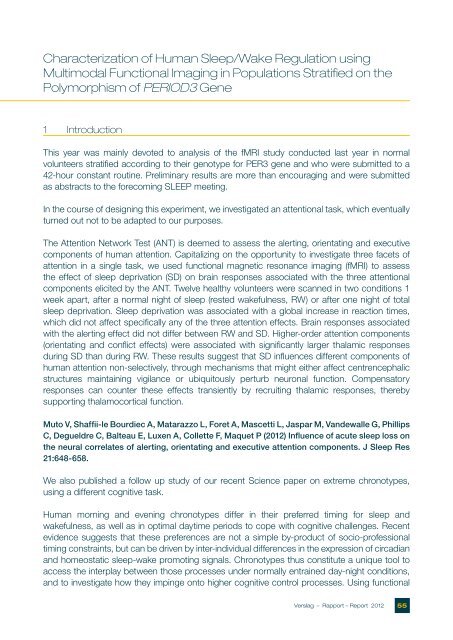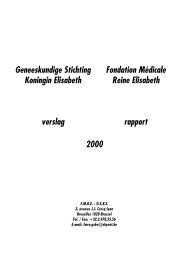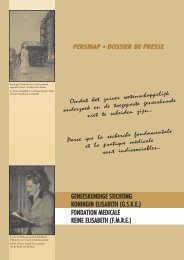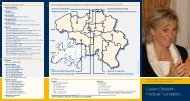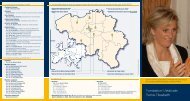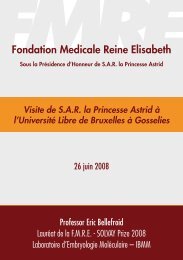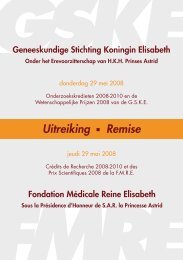Verslag – Rapport – Bericht – Report - GSKE - FMRE
Verslag – Rapport – Bericht – Report - GSKE - FMRE
Verslag – Rapport – Bericht – Report - GSKE - FMRE
Create successful ePaper yourself
Turn your PDF publications into a flip-book with our unique Google optimized e-Paper software.
Characterization of Human Sleep/Wake Regulation using<br />
Multimodal Functional Imaging in Populations Stratified on the<br />
Polymorphism of PERIOD3 Gene<br />
1 Introduction<br />
This year was mainly devoted to analysis of the fMRI study conducted last year in normal<br />
volunteers stratified according to their genotype for PER3 gene and who were submitted to a<br />
42-hour constant routine. Preliminary results are more than encouraging and were submitted<br />
as abstracts to the forecoming SLEEP meeting.<br />
In the course of designing this experiment, we investigated an attentional task, which eventually<br />
turned out not to be adapted to our purposes.<br />
The Attention Network Test (ANT) is deemed to assess the alerting, orientating and executive<br />
components of human attention. Capitalizing on the opportunity to investigate three facets of<br />
attention in a single task, we used functional magnetic resonance imaging (fMRI) to assess<br />
the effect of sleep deprivation (SD) on brain responses associated with the three attentional<br />
components elicited by the ANT. Twelve healthy volunteers were scanned in two conditions 1<br />
week apart, after a normal night of sleep (rested wakefulness, RW) or after one night of total<br />
sleep deprivation. Sleep deprivation was associated with a global increase in reaction times,<br />
which did not affect specifically any of the three attention effects. Brain responses associated<br />
with the alerting effect did not differ between RW and SD. Higher-order attention components<br />
(orientating and conflict effects) were associated with significantly larger thalamic responses<br />
during SD than during RW. These results suggest that SD influences different components of<br />
human attention non-selectively, through mechanisms that might either affect centrencephalic<br />
structures maintaining vigilance or ubiquitously perturb neuronal function. Compensatory<br />
responses can counter these effects transiently by recruiting thalamic responses, thereby<br />
supporting thalamocortical function.<br />
Muto V, Shaffii-le Bourdiec A, Matarazzo L, Foret A, Mascetti L, Jaspar M, Vandewalle G, Phillips<br />
C, Degueldre C, Balteau E, Luxen A, Collette F, Maquet P (2012) Influence of acute sleep loss on<br />
the neural correlates of alerting, orientating and executive attention components. J Sleep Res<br />
21:648-658.<br />
We also published a follow up study of our recent Science paper on extreme chronotypes,<br />
using a different cognitive task.<br />
Human morning and evening chronotypes differ in their preferred timing for sleep and<br />
wakefulness, as well as in optimal daytime periods to cope with cognitive challenges. Recent<br />
evidence suggests that these preferences are not a simple by-product of socio-professional<br />
timing constraints, but can be driven by inter-individual differences in the expression of circadian<br />
and homeostatic sleep-wake promoting signals. Chronotypes thus constitute a unique tool to<br />
access the interplay between those processes under normally entrained day-night conditions,<br />
and to investigate how they impinge onto higher cognitive control processes. Using functional<br />
<strong>Verslag</strong> <strong>–</strong> <strong>Rapport</strong> <strong>–</strong> <strong>Report</strong> 2012 55


